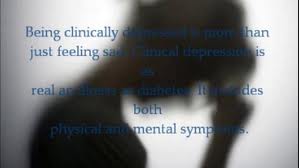 Clinical depression is a serious medical illness affecting 9.9 million American adults, or approximately 5 percent of the adult population in a given year. Unlike normal emotional experiences of sadness, loss, or passing mood states, clinical depression is persistent and can significantly interfere with an individual’s thoughts, behavior, mood, activity, and physical health. Among all medical illnesses, clinical depression is the leading cause of disability in the U.S. and many other developed countries.
Clinical depression is a serious medical illness affecting 9.9 million American adults, or approximately 5 percent of the adult population in a given year. Unlike normal emotional experiences of sadness, loss, or passing mood states, clinical depression is persistent and can significantly interfere with an individual’s thoughts, behavior, mood, activity, and physical health. Among all medical illnesses, clinical depression is the leading cause of disability in the U.S. and many other developed countries.
More than twice as many women (6.7 million) as men (3.2 million) suffer from clinical depressive disorder each year. Clinical depression can occur at any age including childhood, the teenage years and adulthood. All ethnic, racial and socioeconomic groups suffer from depression. About three-fourths of those who experience a first episode of depression will have at least one other episode in their lives. Some individuals may have several episodes in the course of a year. If untreated, episodes commonly last anywhere from six months to a year. Left untreated, depression can lead to suicide.
Clinical depression, also known as clinical depression or unipolar depression, is only one type of depressive disorder. Other depressive disorders include dysthymia (chronic, less severe depression) and bipolar depression (the depressed phase of bipolar disorder or manic depression). People who have bipolar disorder experience both depression and mania. Mania involves abnormally and persistently elevated mood or irritability, elevated self-esteem, and excessive energy, thoughts, and talking.
Clinical Depression: Symptoms
The onset of the first episode of clinical depression may not be obvious if it is gradual or mild. The symptoms of clinical depression characteristically represent a significant change from how a person functioned before the illness. The symptoms of depression include:
- persistently sad or irritable mood
- pronounced changes in sleep, appetite, and energy
- difficulty thinking, concentrating, and remembering
- physical slowing or agitation
- lack of interest in or pleasure from activities that were once enjoyed
- feelings of guilt, worthlessness, hopelessness, and emptiness
- recurrent thoughts of death or suicide
- persistent physical symptoms that do not respond to treatment, such as headaches, digestive disorders, and chronic pain
When several of these symptoms of depressive disorder occur at the same time, last longer than two weeks, and interfere with ordinary functioning, professional treatment is needed.
Causes of Clinical Depression
There is no single cause of clinical depression. Psychological, biological, and environmental factors may all contribute to its development. Whatever the specific causes of depression, scientific research has firmly established that clinical depression is a biological brain disorder.
Norepinephrine, serotonin, and dopamine are three neurotransmitters (chemical messengers that transmit electrical signals between brain cells) thought to be involved with clinical depression. Scientists believe that if there is a chemical imbalance in these neurotransmitters, then clinical states of depression result. Antidepressant medications work by increasing the availability of neurotransmitters or by changing the sensitivity of the receptors for these chemical messengers.
Scientists have also found evidence of a genetic predisposition to clinical depression. There is an increased risk for developing depression when there is a family history of the illness. Not everyone with a genetic predisposition develops depression, but some people probably have a biological make-up that leaves them particularly vulnerable to developing depression. Life events, such as the death of a loved one, a major loss or change, chronic stress, and alcohol and drug abuse, may trigger episodes of depression. Some illnesses such as heart disease and cancer and some medications may also trigger depressive episodes. It is also important to note that many depressive episodes occur spontaneously and are not triggered by a life crisis, physical illness, or other risks.